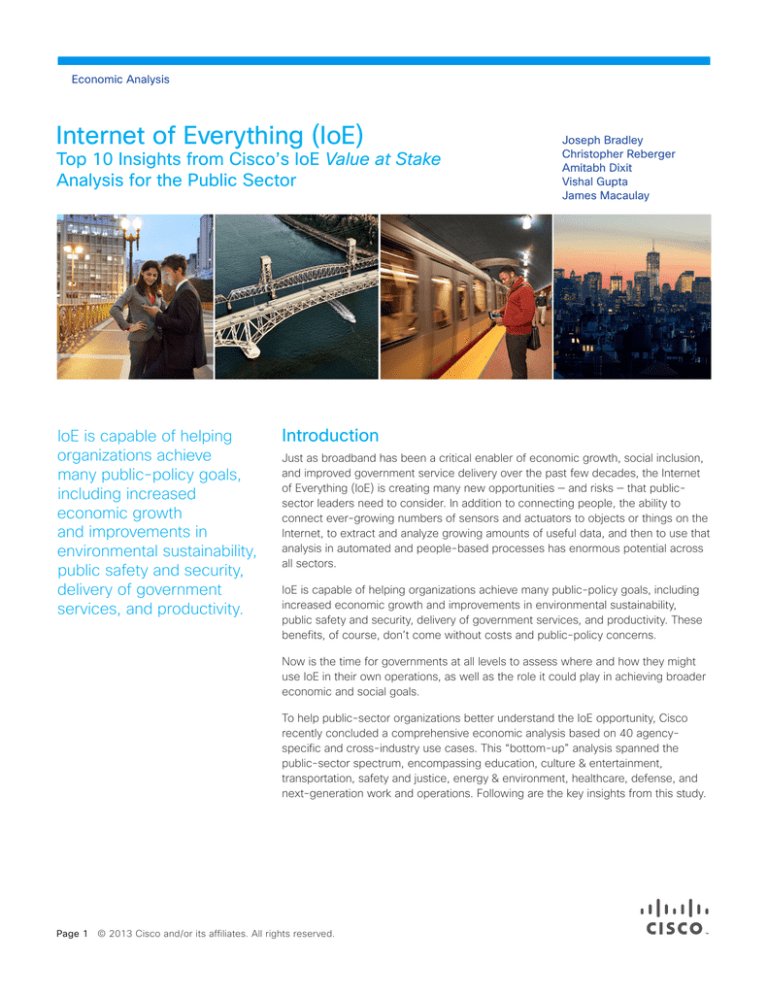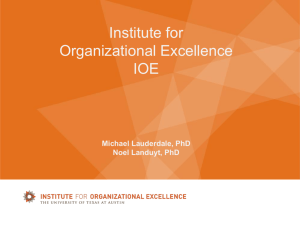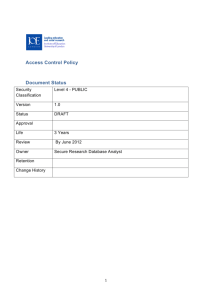Internet of Everything (IoE) Value at Stake Analysis for the Public Sector Introduction
advertisement

Economic Analysis Internet of Everything (IoE) Top 10 Insights from Cisco’s IoE Value at Stake Analysis for the Public Sector IoE is capable of helping organizations achieve many public-policy goals, including increased economic growth and improvements in environmental sustainability, public safety and security, delivery of government services, and productivity. Joseph Bradley Christopher Reberger Amitabh Dixit Vishal Gupta James Macaulay Introduction Just as broadband has been a critical enabler of economic growth, social inclusion, and improved government service delivery over the past few decades, the Internet of Everything (IoE) is creating many new opportunities — and risks — that publicsector leaders need to consider. In addition to connecting people, the ability to connect ever-growing numbers of sensors and actuators to objects or things on the Internet, to extract and analyze growing amounts of useful data, and then to use that analysis in automated and people-based processes has enormous potential across all sectors. IoE is capable of helping organizations achieve many public-policy goals, including increased economic growth and improvements in environmental sustainability, public safety and security, delivery of government services, and productivity. These benefits, of course, don’t come without costs and public-policy concerns. Now is the time for governments at all levels to assess where and how they might use IoE in their own operations, as well as the role it could play in achieving broader economic and social goals. To help public-sector organizations better understand the IoE opportunity, Cisco recently concluded a comprehensive economic analysis based on 40 agencyspecific and cross-industry use cases. This “bottom-up” analysis spanned the public-sector spectrum, encompassing education, culture & entertainment, transportation, safety and justice, energy & environment, healthcare, defense, and next-generation work and operations. Following are the key insights from this study. Page 1 © 2013 Cisco and/or its affiliates. All rights reserved. Economic Analysis Insight No. 1: Internet of Everything is poised to generate $19 trillion in Value at Stake over the next 10 years (2013-2022) for the private and public sectors combined. • The private sector will account for $14.4 trillion, while $4.6 trillion of this value will come from the public sector. • These estimates are based on a bottom-up analysis of 61 use cases, including 21 for the private sector and 40 in the public sector. • The private-sector estimate includes both industry-specific and cross-industry use cases, while the public-sector number covers cities, agencies, and verticals such as healthcare, education, and defense. The four primary drivers of IoE Value at Stake for the public sector are 1) employee productivity, 2) cost reduction, 3) citizen experience, and 4) increased revenue. Insight No. 2: Of the $4.6 trillion in Value at Stake for the public sector over the next decade, 70 percent will be agency-specific, while 30 percent will be driven by cross-agency adoption of IoE. • For the public sector, Value at Stake is defined as “the potential value that can be created by public-sector organizations based on their ability to harness IoE over the next decade (2013-2022).” • The public sector Value at Stake estimate includes: • Benefits for agencies, employees, and citizens • Quantified citizen outcomes (such as reduced congestion, crime, etc.) • Hard cost savings, increased revenues, and productivity gains • Allowances for implementation and operational costs • The public sector Value at Stake estimate does not include: • Privately owned citizen services • Private-sector impact from public expenditure Insight No. 3: The four primary drivers of IoE Value at Stake for the public sector are 1) employee productivity, 2) cost reduction, 3) citizen experience, and 4) increased revenue. • Employee productivity ($1.849 trillion): improved labor effectiveness for new and existing services • Connected defense ($1.5 trillion): force-multiplier effect (4X) through improved situational awareness and connected command centers, vehicles, and supplies • Cost reduction ($740 billion): improved labor efficiency; better CapEx utilization, leading to reduced operational costs Page 2 © 2013 Cisco and/or its affiliates. All rights reserved. Economic Analysis • Citizen experience ($412 billion): shorter “search” times; improved environment; better health outcomes • Increased revenue ($125 billion): improved ability to match supply with demand; improved monitoring and compliance Insight No. 4: More than two-thirds of IoE’s Value at Stake for the public sector will be powered by people (citizen)-centric connections. • Person-to-person (collaboration-centric) and machine-to-person/person-tomachine (analytics-centric) connections will deliver 69 percent of IoE’s value for the public sector. • Person-to-person connections include, for example, telework, BYOD, connected learning, mobile collaboration, and travel avoidance. • Examples of machine-to-person/person-to-machine connections include video surveillance, smart parking, disaster response, and inpatient monitoring. Person-to-person (collaboration-centric) and machine-to-person/ person-to-machine (analytics-centric) connections will deliver 69 percent of IoE’s value for the public sector. Insight No. 5: The $4.6 trillion in IoE Value at Stake for the public sector is equivalent to about one-third of the expected civilian labor productivity growth over the next 10 years. • Worldwide public sector labor productivity increases by around 3 percent each year. Dividing the civilian value generated each year by the expected annual salary costs provides a 1 percent improvement annually. The remaining productivity growth is likely due to increased training and use of unconnected (“dark”) assets. • City budgets vary, although transportation, public safety, and waste management often represent about half of a total budget. Based on the expected impact of IoE, a city could expect to improve services (or decrease costs) in the short term by about 5 percent. Insight No. 6: IoE is already delivering value for the public sector. For example: • 7 percent crime reduction based on smart lighting (U.K.) • 15 percent travel savings due to immersive video (high-definition video collaboration, U.S.) • 30 percent reduction in waste-collection costs driven by usage of sensors (U.S.) • $950 savings per court appearance through use of video technology (U.S.) Page 3 © 2013 Cisco and/or its affiliates. All rights reserved. Economic Analysis Insight No. 7: Ninety-five percent of IoE’s total Value at Stake for the civilian public sector will be driven by just over half (23) of the use cases analyzed by Cisco. • There are 350 million public employees in the world, and the use cases that improve labor productivity are some of the largest. These, combined with opportunities in education and security, provided the main global benefits. • For federal agencies, Next-Generation Workforce represents the largest opportunity to realize IoE value. Cities experiencing budget constraints should focus on IoE’s revenue-generating use cases such as smart parking, water management, and gas monitoring — the “killer apps” for cities. Insight No. 8: Cities will generate almost two-thirds of IoE’s overall civilian benefits globally. To maximize value, cities should strive to combine use cases, rather than approaching them individually. • Cities will claim 63 percent of IoE’s total civilian benefits over the next decade, compared with 22 percent for states/provinces and 15 percent for federal. • To maximize ROI on their energy/environmental investments, cities should employ strategies that combine water management, smart grid, waste management, particulate monitoring, and gas monitoring, rather than attempting to implement them individually. • Public-private partnerships provide cities with an opportunity both to defray costs and increase IoE benefits for government, citizens, and industries. • Cities experiencing budget constraints should focus on IoE’s revenue-generating use cases, such as smart parking, water management, and gas monitoring — the “killer apps” for cities. • To maximize IoE benefits, cooperation across city functions and departments (including resource sharing) is essential. Insight No. 9: To realize value from IoE, public-sector organizations must address strategic, cultural, and operational questions. • Leadership: What are the most valuable IoE opportunities? Where do I start? What is the long-term vision? • Governance: How do we fund a shared IoE infrastructure? How do we measure success? • Competence: Which skills do we need to develop to realize IoE value? Which partners do I need to involve? • Technology: Which IoE use cases will fund our platform investments? Page 4 © 2013 Cisco and/or its affiliates. All rights reserved. Economic Analysis Public-sector leaders have a unique opportunity to “act” rather than “react.” Insight No. 10: Public-sector leaders have a unique opportunity to “act” rather than “react.” To get started, public-sector leaders should: • Determine which IoE capabilities their organizations have today • Harness the complementary insights of both service and IT leaders • Identify major IoE opportunity areas and establish an IoE vision • Reach out to other organizations to share the benefits of IoE platforms • Build an “IoE culture” by helping employees imagine the possibilities of connecting the unconnected

![Project Title Information sheet for [name of adult participant group]](http://s2.studylib.net/store/data/012661992_1-ca2e4a2b9452dea0c78f27fbbcf43de5-300x300.png)

